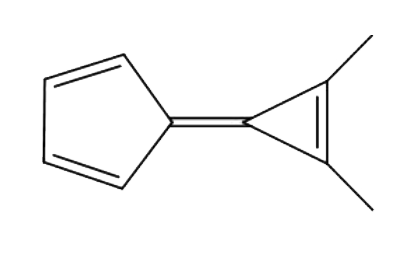The organic compound having a double carbon-carbon covalent bond is :
C3H8
C3H6
C3H4
C4H10
To solve the question, "The organic compound having a double carbon-carbon covalent bond is:", we need to analyze the given organic compounds and determine which one contains a double bond between carbon atoms.
1. Identify the Compounds: We have four organic compounds to analyze:
- Option 1: C3H8
- Option 2: C3H6
- Option 3: C3H4
- Option 4: C4H10
2. Analyze Option 1 (C3H8):
- Structure: C3H8 has 3 carbon atoms and 8 hydrogen atoms.
- Each carbon can form 4 bonds.
- In this case, all carbon atoms can be connected with single bonds to satisfy the tetravalency (4 bonds) of each carbon atom.
- Conclusion: There are no double bonds between carbon atoms in C3H8.
Hint: Check the tetravalency of each carbon atom to see if a double bond is necessary.
3. Analyze Option 2 (C3H6):
- Structure: C3H6 has 3 carbon atoms and 6 hydrogen atoms.
- Each carbon can form 4 bonds.
- If we try to arrange the atoms, we find that two carbon atoms can form a double bond to satisfy the tetravalency of all carbon atoms.
- Conclusion: C3H6 can have a double bond between two carbon atoms.
Hint: Look for the possibility of rearranging bonds to fulfill tetravalency and create a double bond.
4. Analyze Option 3 (C3H4):
- Structure: C3H4 has 3 carbon atoms and 4 hydrogen atoms.
- With only 4 hydrogens, we can arrange the structure to have two double bonds or one double bond and one single bond.
- Conclusion: C3H4 can also have a double bond between two carbon atoms.
Hint: Consider how fewer hydrogen atoms can lead to the necessity of double bonds.
5. Analyze Option 4 (C4H10):
- Structure: C4H10 has 4 carbon atoms and 10 hydrogen atoms.
- All carbon atoms can be connected with single bonds, satisfying the tetravalency of each carbon atom.
- Conclusion: There are no double bonds in C4H10.
Hint: Confirm that the number of hydrogen atoms allows for only single bonds.
Final Conclusion:
The organic compounds that contain a double carbon-carbon covalent bond are:
- Option 2: C3H6
- Option 3: C3H4
Summary:
The correct answers for the question are Option 2 (C3H6) and Option 3 (C3H4), as both have a double carbon-carbon covalent bond.
- Option 1: C3H8
- Option 2: C3H6
- Option 3: C3H4
- Option 4: C4H10
- Structure: C3H8 has 3 carbon atoms and 8 hydrogen atoms.
- Each carbon can form 4 bonds.
- In this case, all carbon atoms can be connected with single bonds to satisfy the tetravalency (4 bonds) of each carbon atom.
- Conclusion: There are no double bonds between carbon atoms in C3H8.
- Structure: C3H6 has 3 carbon atoms and 6 hydrogen atoms.
- Each carbon can form 4 bonds.
- If we try to arrange the atoms, we find that two carbon atoms can form a double bond to satisfy the tetravalency of all carbon atoms.
- Conclusion: C3H6 can have a double bond between two carbon atoms.
- Structure: C3H4 has 3 carbon atoms and 4 hydrogen atoms.
- With only 4 hydrogens, we can arrange the structure to have two double bonds or one double bond and one single bond.
- Conclusion: C3H4 can also have a double bond between two carbon atoms.
- Structure: C4H10 has 4 carbon atoms and 10 hydrogen atoms.
- All carbon atoms can be connected with single bonds, satisfying the tetravalency of each carbon atom.
- Conclusion: There are no double bonds in C4H10.
The organic compounds that contain a double carbon-carbon covalent bond are:
- Option 2: C3H6
- Option 3: C3H4
The correct answers for the question are Option 2 (C3H6) and Option 3 (C3H4), as both have a double carbon-carbon covalent bond.
Topper's Solved these Questions
- MODEL PAPER -1BOOK - ICSECHAPTER - MODEL PAPER -1EXERCISE - SECTION -II
48 Videos
- METALLURGYBOOK - ICSECHAPTER - METALLURGYEXERCISE - UNIT TEST PAPER 6 - Metallurgy (Select the correct answer from the list A,B,C & given in each statement.)
5 Videos
- MODEL PAPER-2BOOK - ICSECHAPTER - MODEL PAPER-2EXERCISE - SECTION-II
56 Videos
Similar Questions
Knowledge Check
Choose the correct answer from the options given below :
The organic compound having a triple carbon carbon covalent bond, is :AC3H4BC3H6CC3H9DC4H10Wittig reaction :
The reaction of a phosphorus ylide with an aldehyde (or) ketone introduces a carbon-carbon double bond is place of the carbonyl bond.

Driving froce of the reaction is high bond energy of (P = O). (ΔH=−ve).
 , Major product (A) is :A
, Major product (A) is :A B
B C
C D
D
Wittig reaction :
The reaction of a phosphorus ylide with an aldehyde (or) ketone introduces a carbon-carbon double bond is place of the carbonyl bond.

Driving froce of the reaction is high bond energy of (P = O). (ΔH=−ve).
 , Major product (A) is Acis-2-buteneBtrans-2-buteneCiso-buteneD1-butene
, Major product (A) is Acis-2-buteneBtrans-2-buteneCiso-buteneD1-butene
Ordinarily the barrier to rotation about a carbon - carbon double bond is quite high but in compound P double bond between two rings was observed by NMR to have a rotational energy barrier of only about 20 cal/mol., showing that it has lot of single bond character.

The reason for this is
View SolutionExplain the formation of carbon-carbon double bond in ethene.
View SolutionThe carbon-carbon bond order in benzene is
View SolutionThe carbon - carbon bond length in graphite is :
View SolutionWittig reaction :
The reaction of a phosphorus ylide with an aldehyde (or) ketone introduces a carbon-carbon double bond is place of the carbonyl bond.

Driving froce of the reaction is high bond energy of (P = O). (ΔH=−ve).
 . Product (A) is :
. Product (A) is :
View Solution